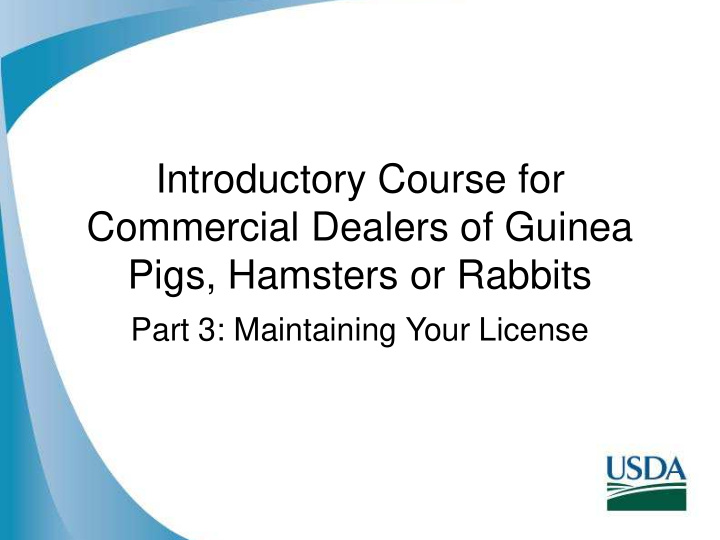



Introductory Course for Commercial Dealers of Guinea Pigs, Hamsters or Rabbits Part 3: Maintaining Your License
Learning Objectives By the end of this presentation you should be able to do the following: 1. Describe annual renewal process 2. Describe how to notify APHIS Animal Care of changes in ownership or location 3. Explain the compliance inspection process 4. Explain how inspection results are reported to licensees 5. Describe how to dispute inspection findings 6. Describe what records are publicly available 7. Explain license suspension or revocation
Renewing Your License
Renewing Your License • Valid one year from date issued • Licensee’s responsibility to renew • Renewal application and fees must be received on or before expiration of current license – If you miss the deadline, you will have to start licensing process over
APHIS Form 7003 • Submit the following materials to the Office serving your State: – APHIS Form 7003 – $10.00 application fee – License fee – Taxpayer Identification sheet
Changes in Ownership or Business Location
Changes in Ownership or Business Location • License only applies to person(s) and the location listed on application form • Not transferrable – Can’t transfer on sale of property – New location must be inspected before conducting business
Notice • Send notification of change to the Office covering your state • Send notice within 10 days of change • Certified mail
Example • Bob and Suzanne hold a Class A license for a facility where they breed rabbits • On June 22, Bob and Suzanne get divorced • Bob is going to continue to operate the facility • What, if anything, must Bob do?
Example (cont’d) • Bob must notify the Animal Care Office by certified mail no later than July 2, that Suzanne will no longer be an owner of the facility
Inspections
Non-Interference by Licensee • Dealers, exhibitors, breeders, caretakers, or researchers who interfere with the inspector’s duties are in violation of the AWA
Compliance Inspections • Unannounced – Any business day during regular business hours – As often as necessary to enforce AWA, but typically once a year • Risk Based Inspection System (RBIS) – Used to determine how often to inspect – Based on: • Facility’s compliance record • Inspector’s professional judgment and discretion • Other factors
Attempted Inspections • Licensee or designee not available – Inspector will attempt to locate licensee for inspection • Reported as an Attempted Inspection • Repeated Attempted Inspections could result in enforcement
Complaint Inspections • Inspection may be conducted in response to a complaint received by Animal Care
Inspection Procedures
Inspection Procedures • Licensee (or designee) goes with Inspector • Provide Inspector access to all areas of facility, including all animals • Inspector explains deficiencies • May take photos or video, copy records • Provide Inspector place to work • May complete report off-site
Areas Inspected • Facilities: – Housing – Primary enclosures – Temperature – Ventilation – Lighting – Interior surfaces – Compatibility
Areas Inspected (cont’d) • Animals: – Adequate veterinary care – Compatibility • Animals housed together by species
Areas Inspected (cont’d) • Husbandry – Sanitation – Pest control – Feeding & watering – Handling – Transportation – Recordkeeping
Exit Briefing • Inspector meets with licensee: – Review report findings • Discuss noncompliant items • Answer questions – Provide copy of report • May send report by certified mail or email – Obtain signature – Correction date
Licensee’s Opportunities • Exit Briefing is opportunity to: – Discuss noncompliant items – Ask about ways to correct deficiencies – Discuss disagreements about report findings – Learn about AWA requirements – Ask questions
Signing the Report • Signature means: – Seen the report – Received a copy • Signature does NOT mean: – Agree with findings – Can’t dispute findings • If report not available at exit interview, signature through certified mail or email acknowledgment
Disagreements • If you disagree with the Inspector’s findings, you may: – Discuss your concerns with the Inspector – Submit written appeal to the Animal Care Office within 21 days
Public Access Inspection Records • Freedom of Information Act: public access to reports • Facility inspection reports on the APHIS Animal Care website http://www.aphis.usda.gov/wps/portal/aphis/our focus/animalwelfare • Monthly press releases of enforcement actions on APHIS Animal Care website
Inspection Reports
Suspension or Revocation of License
License Suspension or Revocation • Administrator can order: if reason to believe violation of regulations or provision of the Animal Welfare Act • Temporary Suspension – 21 days – Oral or written notice – No business conducted during this time – Further action under Uniform Rules of Practice, Department of Agriculture • No renewals during suspension • Must apply to Animal Care Director for reinstatement • Fines may be imposed
Conclusion You should now know: 1. Process for annual renewal of license 2. Notice on change of ownership or location 3. Compliance inspection process 4. How inspection results are reported 5. How to dispute inspection findings 6. What records are publicly available 7. What happens during a suspension or revocation
Questions?
Acknowledgments This presentation was prepared by the Center for Food Security and Public Health, Iowa State University through a cooperative agreement with USDA APHIS Animal Care.
Recommend
More recommend